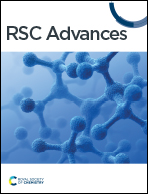Real time optical detection of gold in living cells through genetically-encoded probe†
Abstract
To study the efflux of gold (Au) in living cells, a genetically encoded fluorescence resonance energy transfer (FRET)-based sensor has been developed. The gold-sensing domain GolB from Salmonella typhimurium has been fused to the N- and C-termini of the FRET pair enhanced cyan fluorescent protein (ECFP) and Venus respectively. In living cells, this probe is highly selective and sensitive to gold and it can withstand changes in variable pH ranges. GolSeN-25, the most efficient sensor variant, binds gold with an affinity (Kd) of 0.3 × 10−6 M, covering gold concentrations of nM to μM, and can be used for non-invasive real-time in vivo gold measurement in living cells. A simple and sensitive FRET probe was designed for the detection of gold with high selectivity and can be applied to the analysis of real samples.



 Please wait while we load your content...
Please wait while we load your content...